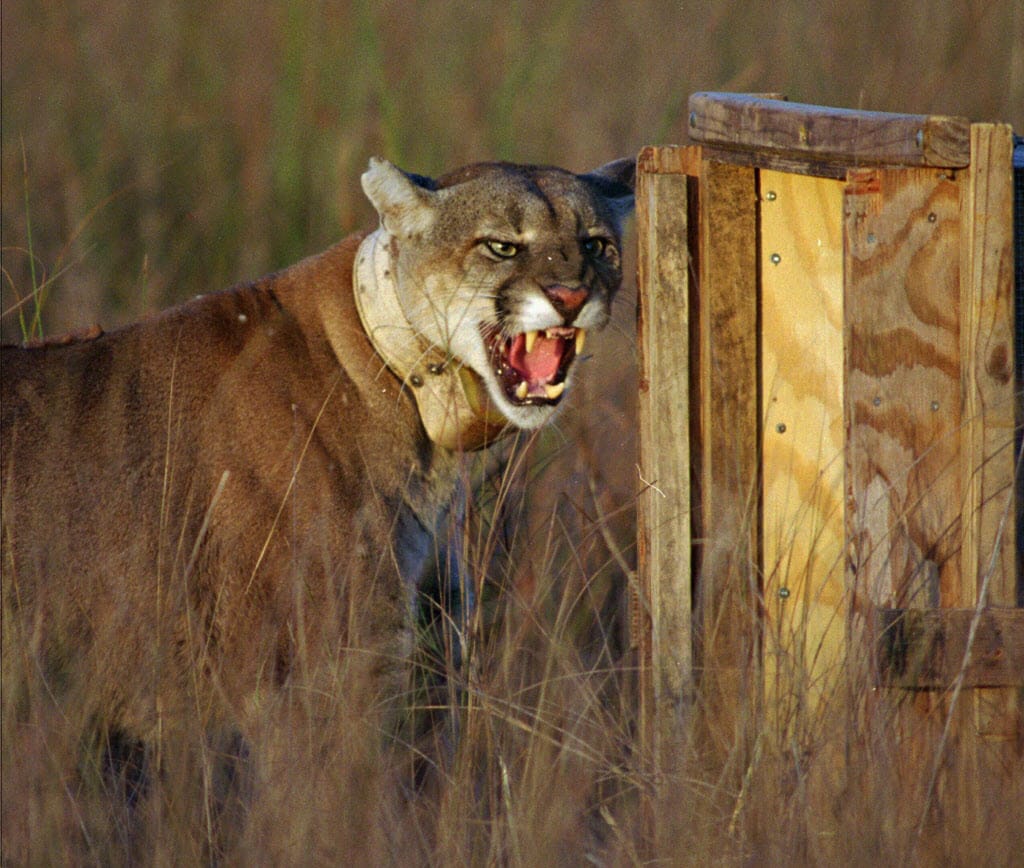FORT LAUDERDALE, Fla. — In a remote part of southwestern Palm Beach County, as a platoon of reporters and photographers watched, a Florida panther was lowered to the ground in a crate.
The panther, raised for 18 months in captivity after his mother’s death, crept out, took a look around, bolted down a dirt road and disappeared into the forest, a heartwarming Born Free image that appeared in newspapers and on TV.
Nine months later, he was dead of pneumonia.
Such a fate is common for male panthers rescued and released by state wildlife officers. Seventeen panthers have been released since the program started in 1987. All eight males are dead, three killed by other panthers, one by a vehicle, two by disease and two by unknown causes. Another could not be found after his tracking collar failed.
The Florida panther’s cramped South Florida habitat holds about as many panthers as it can, and males let loose into this environment are at greater risk of being killed by other males defending their territory. Females typically do better and have produced many kittens.
Despite the difficult path ahead, experts say the releases are not just feel-good wastes of money. With just 100 to 160 panthers remaining in the wild, any panthers added to the population help reduce its vulnerability to in-breeding or natural disaster.
“Every panther life is important at this point because you’re dealing with one of the most critically endangered species in the United States,” said Jennifer Hecker, director of natural resource policy for the Conservancy of Southwest Florida. “A catastrophic event like a fire or a hurricane could decimate the entire species.”
But many people who live or hunt around panther habitat oppose any program that adds more of the cats to land already saturated with them. They say there are many more panthers than the state’s estimates suggest, the panthers are losing their fear of people and are so desperate for territory that they’re turning up around populated areas. Last week, the wildlife agency captured and relocated a young male found by a Collier County beach.
“There’s no place for them to go,” said Shirley Harner, of Boca Raton, who owns land with her husband north of Big Cypress. “They’re running out of food, and they’re getting desperate. That’s why they get urban, that’s why they found one on the beach, that’s why pets are being eaten. It’s cruel to the cats.”
Although there have been no documented attacks on people by Florida panthers, the species has accounted for fatalities in western states, where it’s known as the cougar or mountain lion.
Development on the west coast continues to erode habitat, with the latest threat the possibility of increased oil drilling. Squeezed into this shrinking area, 15 panthers were killed last year by vehicles and three by other panthers.
“We’re facing enormous challenges with regard to protecting the remaining habitat of the panther,” said Hecker.
The work going into rescuing panthers can be highly elaborate. Injured panthers require medical treatment. Orphaned panthers are taken to the White Oak Conservation Center near Jacksonville where they grow up with minimal human contact and learn to hunt on their own.
The costs vary. The wildlife agency says it ranges from $400 a month to care for three kittens whose mother died, to $3,000 a month to treat a panther with a broken leg. Although some veterinary services are donated, the state pays most of the bills.
Of the nine females released, eight have produced kittens. One female, rescued on the death of her mother, has produced seven litters totaling 12 kittens, and she’s still out there.
But any male released will find himself plopped into a hostile world. One panther, rescued after his mother died, was killed by another male less than two months after his release into Big Cypress National Preserve.
“They have a much harder time surviving to adulthood than females,” said Mark Lotz, panther biologist for the FWC. “So that is why we see some of these males getting picked off so quickly.”



